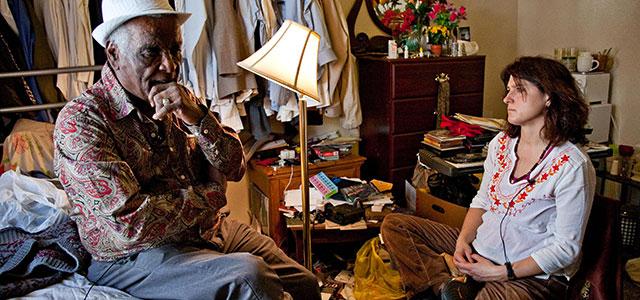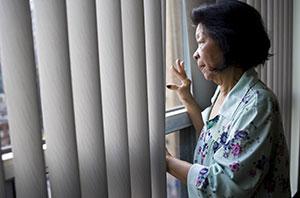
Elena Portacolone speaks with a 76-year-old man living on his own in San Francisco.
How We Age: Elena Portacolone Looks at Older Adults Living Alone
In July 1995, as Chicago sweltered in temperatures that soared to over 100°F, more than 500 people died – largely the isolated elderly, many of whom who couldn’t afford air conditioning and were often too afraid to leave doors or windows open in their crime-plagued neighborhoods. The disaster highlighted one of the key challenges confronting an aging America: How do we ensure the well-being of an increasing number of people living alone in older age?
That’s the question sociologist Elena Portacolone, assistant professor at the Institute for Health & Aging and Pepper Center Scholar at the Division of Geriatrics in the Department of Medicine at UCSF, hopes ultimately to answer. “I’m very passionate about the care of older adults, especially how to help them remain in the community,” she says.
A Passion for Working with Older Adults
Portacolone’s interest in how we age began in the 1990s with a stint as a nursing home volunteer in Italy, where she grew up. Her interest remained with her even as she traveled all over the world, managing international projects for CNH Global NV, a large multinational manufacturer of agricultural and construction equipment.
“Although it was really exciting, I asked myself, When was the last time I was really fulfilled? It was when I was helping dying older adults,” she says.
She left her job to join the MBA/MPH Program at UC Berkeley, which she completed in 2002. After a year as an intern with the World Health Organization in Geneva, she continued her work with older adults at the nonprofit LifeLong Medical Care in Berkeley.
In 2005, Portacolone began her PhD training in sociology at UC San Francisco School of Nursing with the intention of exploring alternatives to nursing homes, using On Lok’s programs for integrated care for the elderly as a model. But one of her mentors, Sharon Kaufman, pushed Portacolone to be more ambitious in her doctoral work.
Portacolone recalls, “Sharon said, ‘On Lok is great, but it serves a limited number of people. You should look at a bigger question in a larger population.’” Reading sociologist Eric Klinenberg’s account of the 1995 Chicago heat wave, Heat Wave: A Social Autopsy of Disaster in Chicago, convinced Portacolone that the phenomenon of older adults living alone was the bigger question she wanted to explore.
The Precariousness of Living Alone in Older Age in the U.S.
Living alone as an older adult is increasingly common throughout the Western world. Nearly a third of adults age 65 and older (11.3 million individuals) live alone in the US. In her doctoral work, Portacolone interviewed 47 San Franciscans age 75 and older who were living alone. A theme that emerged during those encounters was the idea of precariousness, a word that evokes an intrinsic sense of insecurity.
In the case of older Americans living alone, Portacolone found, precariousness derived from their need to prove that they can make it alone at a time when they may need services that are too expensive, limited or difficult to access. At the same time, they may experience a decline in their economic and social resources, as well as in their physical and cognitive abilities.
To make matters more difficult, Portacolone says, “The current emphasis on encouraging elders to be ‘independent’ can actually deter some older solo dwellers from seeking help, which in turn increases their sense of precariousness.” This sense of precariousness, she says, is often experienced by older adults who are not poor enough to qualify for public services yet are not wealthy enough to afford the astronomical prices of private services.
“Realistically, there’s only enough money to serve the neediest,” says Kate Hoepke, executive director of San Francisco Village, a community-based organization that supports older adults who want to remain in their homes. According to Hoepke, around 75 percent of older adults in San Francisco don’t qualify for public services. While the small number of wealthy can generally pay for help (which may or may not be high quality), the majority who fall in the middle of the socioeconomic spectrum are left on their own. “Nobody’s really paying attention to the middle class,” she says.
Increasing Age Segregation
The problems, says Portacolone, are compounded by increasing age segregation. As part of the research project for her PhD (which she received in 2011), she delivered food as a Meals on Wheels volunteer to older adults around San Francisco, which allowed her to observe how they lived. “The big surprise was to discover that there is a myriad of buildings, public and private, where there are only older adults, most of them living alone,” she says. Portacolone grew up in a multigenerational household, raised by her parents and a grandmother in Italy, but that model is slowly disappearing, she says, and she is interested in why.
With UC Berkeley Professor of Bioethics and Medical Humanities Jodi Halpern, Portacolone has looked at the reasons around 10 percent of older US residents move into age-segregated settings. They found that for many, it isn’t a choice but a necessity. “The move toward segregation is more about the fact that official policies, both in the US and outside it, are making it easier for older adults to live in age-segregated settings,” Portacolone says.
While some older adults are attracted to the benefits of senior housing – greater affordability, some more centralized services and a sense of community among one’s peers – others feel forced into it by economic or social factors, including the prevailing emphasis on individual responsibility, which equates needing help with being a burden. “It becomes a moral duty. If you don’t move into these [age-segregated] communities, you are often seen as irresponsible,” says Portacolone.
What are the implications of a society in which generations are increasingly segregated by age? One is that it reinforces biases about older adults being burdens rather than assets. “There’s a lot of stigma around being old,” says Portacolone. “In the news they say, ‘Older adults are using all the resources,’ but it’s not the case. We’re becoming estranged from one another.”
Hoepke agrees. “A lot of young people don’t have interactions with older adults outside their immediate family,” she says. Both worry that increasing estrangement makes it easier for society to ignore the needs of the elderly.
Living Alone with Cognitive Impairment
For the majority of older adults, who prefer to remain in their homes in the community, there is another danger: isolation. “There aren’t many services available, and if you start asking for help, you raise red flags,” says Portacolone. Older tenants are frequently in danger of eviction, and even those with family and friends who are willing to help are often scared to ask. Those who have help, through public or private means, are at risk of exploitation.
 Older adults with dementia or other cognitive impairments may be at particular risk. While research suggests that around 25 percent of adults over age 70 who live in the community have some form of dementia or cognitive impairment, we don’t know much about how they live, says Portacolone. With grants from the UCSF Resource Allocation Program and the Pepper Center, she sought out mentors, including the School’s Julene Johnson, a cognitive neuroscientist, to begin work on a research project that looks at the experience of living alone with dementia or cognitive impairment and what kinds of supports such persons need to do so successfully.
Older adults with dementia or other cognitive impairments may be at particular risk. While research suggests that around 25 percent of adults over age 70 who live in the community have some form of dementia or cognitive impairment, we don’t know much about how they live, says Portacolone. With grants from the UCSF Resource Allocation Program and the Pepper Center, she sought out mentors, including the School’s Julene Johnson, a cognitive neuroscientist, to begin work on a research project that looks at the experience of living alone with dementia or cognitive impairment and what kinds of supports such persons need to do so successfully.
Johnson says, “The project pushes the boundaries into areas where there hasn’t been much discussion. We don’t really know how older adults who live alone experience the decision-making process on a day-to-day basis.”
Portacolone is spending time with older adults living alone with Alzheimer’s disease or mild cognitive impairment, learning about their challenges and how it feels to live alone with less memory than in the past. “It’s like entering into another dimension,” she says. “Imagine that after we speak on the phone, you don’t remember what was said.”
She’s looking at the ways people cope – relying on double calendars to remind them of things, or even calling 311 – a service to help San Francisco residents with nonurgent government matters – to find out what day it is. Many are afraid to let on to family and friends how much memory they’ve lost because they don’t want to be pressured to move out of their homes. “They tend to keep a low profile,” says Portacolone. “They have techniques, like using generic sentences or humor, to hide the fact that they have less memory than before.” She tells of one woman who, looking for an item, couldn’t recall where she’d put it. “She told me, ‘It’s in a safe place. It’s so safe, I don’t even know where it is.’”
There are also those who cannot cope. Portacolone recalls a woman who decided to end her life because it became too challenging to deal with her worsening forgetfulness.
Johnson and Portacolone are pursuing grant funding to continue the research in the hope that it can inform policy that will help older adults age in place well. Johnson says, “A new area could evolve, especially with the baby boomers pushing the edge of their autonomy in older age. Who knows what kinds of services could be developed?”
Other Risks Confront the Isolated Elderly
Mindful of Kaufman’s admonition to take the broad view in her work, Portacolone is looking at other issues that affect the health and well-being of older adults living alone. She’s working with Robyn Gershon, professor in the Department of Epidemiology and Biostatistics and UCSF’s Philip R. Lee Institute for Health Policy Studies, on a National Institute of Nursing Research-funded project to study emergency preparedness among older adults living alone in San Francisco and New York. One of Portacolone’s concerns is that they are being asked to take too much responsibility for their own preparedness. “If you are homebound and vulnerable, it’s overwhelming,” she says. “There must be some entity that makes sure that in case of emergency, you are not forgotten.”
A grant from Tideswell at UCSF and the Pepper Center has also allowed Portacolone to expand on a project she initiated with Steven Segal at the UC Berkeley Mack Center on Mental Health and Social Conflict, which looked at the effects of exposure to violence on older adults living alone in high-crime neighborhoods. With UCSF’s Carla Perissinotto and Ryan Greysen, she will continue looking at the factors that determine social isolation and loneliness among that population.
Promoting Interdependence
The importance of interdependence is a thread that runs through Portacolone’s work. She believes that if social norms included the idea that no one must be entirely self-reliant, there would be more services to allow older adults to age in place securely. “We are dependent on others for everything, so the sooner we embrace that, the better. If interdependence was the slogan for programs helping the elderly, there would be a major shift.”
Her research emphasizes the need for connection and interdependence in place of what she calls “the moral imperative of being independent,” in order to develop systems that empower older adults rather than constrain them. As Johnson puts it, “We don’t yet know what we can do as a society to balance the need to be independent and autonomous with the need for care.”
This is the kind of question that may best be addressed by research that combines qualitative with quantitative methods, as Portacolone and her colleagues do. Doing better means finding out not just what is happening to older adults and how often, but how it feels and why. Portacolone hopes that in exploring the stories of older adults, she can help effect change that will benefit them and, ultimately, society. She credits longtime mentor Carroll Estes, founder of the Institute for Health & Aging, for her approach: “I listen to people’s stories, but at its core, I’m looking at the bigger picture.”



